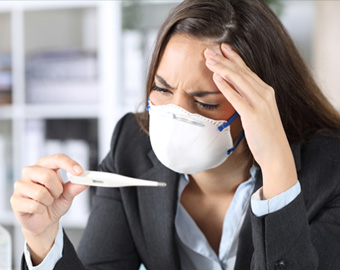Employer Beware: Why Temperature Screening Should Not Be Used
By Julie King | May 12, 2020

Many business owners understandably feel trepidation as they look forward to when and how their offices can reopen.
Without broad-scale testing and contact tracing, the burden of trying to keep employees and customers healthy falls in part on employers who will ultimately need to balance economic and health realities. Business owners want something they can incorporate into their practices to help reduce the chance of the virus spreading in their place of work.
One of the most commonly discussed screening methods is to take temperatures of people entering the workplace. This practice became common in places like Hong Kong, where restaurants screen customers before allowing them into their facility.
It seems like an easy and powerful screening measure. Yet is it that?
Dr. Mabel Hsin, a family physician and executive lead, wellness and health, with Altitude HCM, cautions that businesses owners should consider the numbers before implementing temperature-taking practices. It all boils down to the math.
- Many people who are contagious are asymptomatic.
“First given the fact that it is widely postulated that 25% of Covid infections are asymptomatic (some even state it is as high as 50%), that leaves only 75% of infections being symptomatic,” says Dr. Hsin. “This is one of the reasons the infection had spread so easily and rapidly, because of all the asymptomatic community spread. “
- For people who do show symptoms, fever only presents in half of those cases.
“Second, it is estimated of those who are symptomatic, only 50% have fevers,” says Dr. Hsin. “That means only half of the remaining 75% infections have fevers, or 38% of Covid infections have fevers.”
- Even people who have a fever are less likely to have one during working hours.
“Third, of those with fevers, note that fevers tend to fluctuate, being highest upon waking up in the morning, and in the middle of the night, not during working hours,“ explains Dr. Hsin.
- People who have the most extreme symptoms will be at home.
“Fourth, those who actually have fevers are too ill to go to work anyways,” notes Dr. Hsin.
Added up, Dr. Hsin explains this means that as many as 62% of people infected with Covid-19 can go to work and pass the fever screening test, while the rest are too sick to go to work.
That tally does not include the portion of people who might use medicine to supress any signs of fever, a percentage that is difficult to estimate.
“So, mathematically speaking, taking temperature as a screening tool not only totally useless, but worse, it poses harm,” explains Dr. Hsin. “It gives false sense of safety, poses a sense of personal invasion amongst employees, reduces productivity, and wasted time that can be better used for more constructive actions.”
As much as business might like to have tools to help keep their workplaces safe, taking temperatures as a screening method is a dangerous approach that can create more problems than it attempts to solve.





